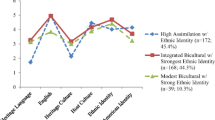Abstract
Enculturation is the process by which individuals learn about and identify with their ethnic minority culture. It is distinguished from acculturation which refers to the process by which an ethnic minority individual is assimilated into the majority culture. Three studies with Native American youths are reported that describe the development of a measure of enculturation for Native American youths. Development of a measure of enculturation provides a foundation upon which to build a body of literature that focuses on strengths in a youth's life rather than on deficits. Results of the first study (n=120), a confirmatory factor analysis, indicated that cultural affinity, Native American identity, and family involvement in traditional activities adequately represent the construct of enculturation. The study also provides some convergent validity for this interpretation. The second study examines factor invariance for enculturation among youths with data from over 2 years (n=69). The factor structure was similar across time. The third study replicates the factor structure and validity analyses with a new sample (n=42). Usefulness of the measure for assessing protective factors and stressing ethnicity over simple assessment of race categories is discussed.
Similar content being viewed by others
References
Aboud, F. E. (1987). The development of ethnic self-identification and attitudes. In J. S. Phinney & M. J. Rotherman (Eds.),Children's ethnic socialization: Pluralism and development (pp. 32–55). Newbury Park, CA: Sage.
Aries, E., & Moorehead, K. (1989). The importance of ethnicity in the development of identity of Black adolescents.Psychological Reports, 65, 75–82.
Bentler, P. M. (1989).EQS structural equations program manual. Los Angeles, CA: BMDP Statistical Software.
Brook, J. S., Brook, D. W., Gordon, A. S., & Whiteman, M. (1990). The psychosocial etiology of adolescent drug use: A family interactional approach.Genetic, Social, and General Psychology Monographs, 116, 111–267.
Grossman, B., Wirt, R., & Davids, A. (1985). Self-esteem, ethnic identity, and behavioral adjustment among Anglo and Chicano adolescents in West Texas.Journal of Adolescence, 8, 57–68.
Helms, J. (1990). Black and white racial identity: Theory, research, and practice. New York: Greenwood.
King, J. (1992).Acculturation scale. Denver, CO: National Center for American Indian/Alaska Native Mental Health Research.
LaFromboise, T., Coleman, H. L. K., & Gerton, J. (1993). Psychological impact of biculturalism: Evidence and theory.Psychological Bulletin, 114, 393–412.
Little Soldier, L. (1985). To soar with the eagles: Enculturation and acculturation of Indian children.Childhood Education, 61, 185–191.
Markstrom-Adams, C., & Spencer, M. (1994). A model of identity intervention with minority adolescents. In S. L. Archer (Ed.),Interventions for adolescent identity development (pp. 84–102). Thousand Oaks, CA: Sage.
Nicols, R. L. (1990–1991). Native American survival in an integrationist society.Journal of American Ethnic History, 10, 87–93.
Oetting, E. R., & Beauvais, F. (1991). Orthogonal cultural identification theory: The cultural identification of minority adolescents.International Journal of the Addictions, 25, 655–685.
Phinney, J. S. (1990). Ethnic identity in adolescents and adults: Review of research.Psychological Bulletin, 108, 499–514.
Phinney, J. S. (1992). The multigroup ethnic identity measure: A new scale for use with diverse groups.Journal of Adolescent Research, 7, 156–176.
Phinney, J. S., & Alipuria, L. L. (1990) Ethnic identity in college students from four ethnic groups.Journal of Adolescence, 13, 171–183.
Phinney, J. S., & Chavira, V. (1992). Ethnic identity and self-esteem: An exploratory longitudinal study.Journal of Adolescence, 15, 271–281.
Phinney, J. S., & Rotherman, M. J. (1987). Children's ethnic socialization: Themes and implications. In J. S. Phinney, & M. J. Rotherman (Eds.),Children's ethnic socialization: Pluralism and development (pp. 274–292), Newbury Park, CA: Sage.
Rosenberg, M. (1965).Society and the adolescent self-image. Princeton, NJ: Princeton University Press.
Rosenthal, D. A. (1987). Ethnic identity development in adolescents. In J. S. Phinney & M. J. Rotherman (Eds.),Children's ethnic socialization: Pluralism and development (pp. 156–179). Newbury Park, CA: Sage.
Rotherman, M. J., & Phinney, J. S. (1987). Introduction: Definitions and perspectives in the study of children's ethnic socialization. In J. S. Phinney & M. J. Rotherman (Eds.),Children's ethnic socialization: Pluralism and development (pp. 10–28). Newbury Park, CA: Sage.
Tajfel, H. (1981).Human groups and social categories. New York: Cambridge University Press.
Trimble, J. E. (1983). Stalking the wily emic: Alternatives to cross-cultural measurement. In S. H. Irvine & J. W. Berry (Eds.),Human assessment and cultural factors (pp. 259–273). New York: Plenum Press.
Trimble, J. E. (1987). Multilinearity of acculturation: Person-situation interactions. In D. M. Keats, D. Munro, & L. Mann (Eds.),Heterogeneity in cross-cultural psychology (pp. 173–186). Amsterdam: Swets & Zeitlinger.
Wilbert, J. (1976). Introduction. In J. Wilbert (Ed.),Enculturation in Latin America: An anthology (pp. 1–28). Los Angeles, CA: UCLA Latin American Center for Publications.
Williams, D. R., Lavizzo-Mourey, R., & Warren, R. C. (1994). Concepts of race and health status in America.Public Health Reports, 109, 26–40.
Zimmerman, M. A., & Arunkumar, R. (1994). Resiliency research: Implications for schools and policy.Social Policy Report, 7, 1–17.
Zimmerman, M. A., Ramirez, J., Washienko, K. M., Walter, B., & Dyer, S. (1994). The enculturation hypothesis: Exploring direct and protective effects among Native American youth. In H. I. McCubbin, E. A. Thompson, & A. I. Thompson (Eds.),Resiliency in ethnic minority families, Vol. 1. Native and immigrant American families (pp. 199–220). Madison: University of Wisconsin.
Author information
Authors and Affiliations
Additional information
We would like to thank the Tribe that participated in this study and especially the youth and their parents who agreed to participate. We would also like to thank the Tribal staff youth workers who helped us on many aspects of the study. This research was supported by the Center for Substance Abuse Prevention, Grant No. 1 H86 SPO1835-01A1 to the Grand Traverse Band of Ottawa/Chippewa Indians.
Benjamin Walter and Kathleen Washienko were research assistants on the project during data collection at Time 1.
Sandra Dyer was the Director for the project upon which this study is based at the time of data collection.
Rights and permissions
About this article
Cite this article
Zimmerman, M.A., Ramirez-Valles, J., Washienko, K.M. et al. The development of a measure of enculturation for Native American youth. Am J Commun Psychol 24, 295–310 (1996). https://doi.org/10.1007/BF02510403
Issue Date:
DOI: https://doi.org/10.1007/BF02510403




